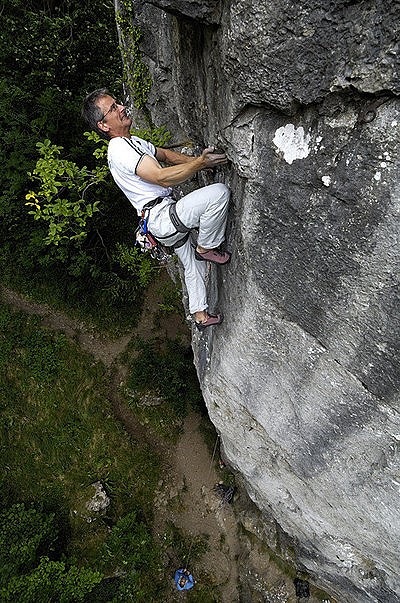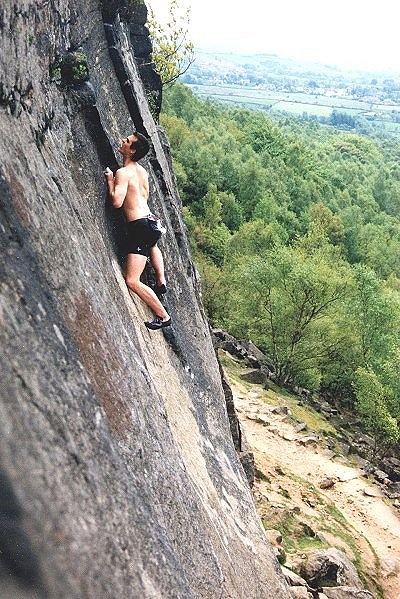

For UK trad routes that information includes:
- Style of ascent
- Grade of route using the UK system
- An additional grade (either bouldering or sport)
This additional grade is not a new idea and has been in published guidebooks since at least 1999 with the FRCC Langdale book.
The British system has extremely wide grades ( for example E7 can range from F7a to F8a in difficulty and Technical 6c can range from Font 6c to Font 7c) and the use of these 'extra grades' helps narrow down the difficulties and provide clear information.
This is not a new step for UKC - however we can only publish these extra grades when we are given that information. We always ask for it.
Example news reports with additional grades:
- Aug 21: Local News: Major Jersey Line Climbed
- Aug 18: Local News: North Wales Quarry Action
- Nov 24: Local News: Aide Jebb, New route on Stanage, E6 7a
We will continue to use these additional grades in our news and articles. We don't think the E grade needs to be replaced, but we do feel that these 'extra grades' are an essential addition.
Looking for a grade debate? Read the UKC article: The E Grade. Is it broken? Can it be fixed?
Read E is for mEdia, to find out if the climbing media really controls top end grading.
Simon Lee has kindly contributed his thoughts on the current grade debate. These are outlined in the article below. Simon is an experienced climber and regular contributor to UKC. You can view his other articles on his profile page: Simon Lee.

Grades and style - by Simon Lee
There has been much discussion of late regarding grading systems on the forums to a point where it was nicely sent up by Steve McClure reporting his New Thing at Raven Tor (UKC News). However, I thought it would be useful to go back to basics to consider the principles underpinning grades and style and the relationship between the two and then put it into context with the bewildering array of potential alternative grading systems.
Grading
Grading seeks to rank routes in order of difficulty. In its starkest form we have the Australian free-climbing grading system which starts at 1 (presumably scrambling) and with successive increments of difficulty goes up as high as 34 currently, I think. Within each grade is a notional linear variance of difficulty so that at say grade 20 you will have routes only marginally harder than 19 and routes only marginally easier than 21 and routes midway between the two which can be described as easy, hard and standard for the grade respectively.
So much, so obvious. However, within each grade you will also be using the concept of equivalent difficulty which is not linear. At grade 20 you will be assessing and comparing the equivalent difficulty of long routes to short routes to routes on different rock types to sustained routes to cruxy routes to steep routes to slabs to cracks to arêtes and so on... In deciding equivalent difficulty you are in effect creating an imaginary average grade 20 climber equally proficient in these varied challenges. He/she doesn't exist, of course, except for illustrative purposes so we shouldn't personalise them too much. Whilst grading is based on average all-round ability at different levels let's not forget that the route itself has an inherent grade independent of the climber i.e. the grade of the route – the climber measures up to the route not the other way around.
This is an axiomatic distinction. You can measure yourself as an all-rounder by the variety of routes that you can climb at a given grade. Variation in ability to climb a grade is down to different individual talents such as strength, desire, stamina, morphology and technique. A specific above average talent would be advantageous on certain routes and irrelevant on others. Conversely a weakness might stop you in your tracks at a grade you would normally be able to climb. Additionally the route is, or should be, graded for a mistake–free ascent. If you have fluffed up a move (however hard to read) and made it harder for yourself then that (surely?) is a personal climbing mistake rather than a grading mistake. The grade will reveal your relative strengths and weaknesses if you were not aware of them already. However, the nuances of style employed on a route will also affect the grade at which you are able to climb. In sport climbing typically a well rounded climber will be able to multi-day redpoint a route two grades harder than his/her in-a-day grade which in turn is two grades harder than their onsight grade. However, if the style of climbing is wholly different then a different grading system is often applied.
Styling
By style I mean the manner in which a climb is done. The Nose of El Capitan, can be climbed in two very different styles. Free and Aid. In this instance equivalence goes out the window. You are no longer comparing apples with pears but something incomparable like rhyme and reason. In the case of the Nose it makes perfect sense to have two different grading systems for the same route depending on the style in which it is climbed. A different grading system makes sense when the style of climbing is so very different that comparative equivalence is no longer possible or useful. Clearly this applies to separating aid climbing, winter climbing and ice climbing but what about different styles of free-climbing? Are they so very different that they require different grading systems? Internationally this distinction has been made between bouldering and route climbing with different grading system used for each. However, whilst leader-placed protected routes exist the world over; to my knowledge it is only in the UK that we have a separate system for leader-placed protected routes. This is, of course, the notorious Adjectival /E grade. Is the UK right and the rest of the World wrong?

To my mind the further you seek to keep the two separate, the better – we are seeking, where possible, to grade a route. A route graded 20 can be climbed with rests, onsight, with beta, ground-up, headpointed on lead or solo. The style used will make the ascent harder or easier but the grade remains the same. Like the speed of light the grade is the constant. This is the case with most climbing grading systems around the world because they seek to quantify the inherent difficulty of the route.
In the UK it is different but only because the Adjectival/E grade adds an extra component – what I am going to call a risk multiplier. So at say E5 we can have a huge breadth of difficulty from French6a+on Hairless Heart to French 7a+ on Moon Crack around the corner. They are rated as having an equivalent level of difficulty because one is protection-less with potentially fatal or disabling consequences and the other is as safe to protect as a grid-bolted sport route. So a hard route with a zero risk multiplier can be judged to be an equivalent grade to a route that is easy with a high risk multiplier.
For a route graded say E2 it is prudent, before launching up it, to work out what part the risk multiplier played in reaching that grade by looking at the route and for some hints in a guidebook. If you are an all rounder at the given grade you will be able to take the diversity of difficulty and risk in your stride and be able to climb all E2's in on-sight style (the default style for mid grade trad climbing) across this spectrum.
When bolted sport routes appeared in the 80's we also used to give them adjectival grades. Because the risk multiplier is zero a sport route is the equivalent of a well protected trad route where the protection is as easy to place as it is to clip a bolt. Even though it 'worked' in translation it was ditched because the breadth of the adjectival grade was exposed as absurdly large and so not as useful and informative as the French grade. One adjectival grade typically lumped in 2 or 3 French grades. Conversely if we apply the French/YDS/German or Australian grading to trad routes we isolate the difficulty aspect but not the danger. To make up for this shortcoming in the US, a supplemental R/X rating was adopted and more recently for deep water soloing an S grade introduced; both sensibly alerting climbers to specific risks on individual routes.
To defenders of the adjectival/E grade the overall embracing of all factors including risk is its great advantage. To me this is its fundamental weakness. By trying to be all things the adjectival grade introduces too many factors and makes it cumbersome and inflexible applied to very diverse routes and also in accommodating the growth and development of different styles and types of free climbing. Risky routes can be made to be significantly less risky or daunting depending on modifications of style in which they are ascended. Where does that leave the E grade on these occasions? Usually in a pickle. And increasingly so too in ever sophisticated times with DVD's and mats with who-knows-what innovations around the corner. The use of the risk multiplier as part of the E grade entangles itself with style when modifications in style can significantly affect the risk of certain routes. It also takes for granted that there is a generally accepted and acceptable way to draw meaningful equivalent comparisons between difficulty and danger. I think this is highly questionable when risk and perception of risk is so variable and personal. Again, are we comparing apples and pears or rhyme and reason?
The E/Adjectival grade was ditched for grading UK sport routes 20 years ago. More recently it has been ditched in deep water soloing. Its use for top-end headpointing is currently being questioned. Efforts to keep the E grade relevant and useful seem to me to go endlessly around in circles discussing terminology and drawing lines in the sand, but to what purpose?. A grading system should be our slave not our master.

Highball bouldering, sporty trad routes (i.e. Rhapsody) and run-out sport routes (i.e. Jumbo Love) are blurring the boundaries, character and accepted notions of what constitutes sport climbing, bouldering and trad climbing. I think it would be refreshing for a minute to set aside the tribal allegiances. Imagine there is just free climbing (it's easy if you try). How does that feel? Now let's suppose we had one grading system to rule them all and bind them. Then you would have a measure of objective difficulty for all free climbing. Against the assigned grade drawn from this one grading system you would choose the most appropriate style for a route you wanted to climb. Depending on your preferences and talents and what the route dictates as sensible you could make it more or less challenging and/or risky. This is a far more authentic and liberating approach to climbing than letting varied grading systems dictate your style and furthermore stereotype you as a boulderer, trad climber, sport climber or headpointer.
Reducing risk through using protection whether it be mats or cams or a top rope is only a major issue when the grading system employed also incorporates an assessment of risk or safety in the way that the adjectival/E grade does. Change the grade system so it focuses on difficulty say V, Font or French and there is no issue. This helps us to grade the route not a style within a style. The adjectival grade is arguably also a system that glorifies risk with implications for those wishing to push their grade or establish new routes. If there is a demand for risk to be quantified then it is better do so separately using the US R/X grade or something similar.
Conclusion
If what I have written sounds cold and clinical then I make no apologies. Any romance for a grade or system or number is by association and familiarity. We can see this in other sports. A sub 4 minute mile is a resonant achievement and more eye-catching than restating that Roger Bannister took 239.4 seconds to run 1.609344 km. A measure is an arbitrary thing later codified as precisely as possible, whether that measure is minutes, miles or grades. The measure itself is measured by how useful it is. If a measure is found wanting like the Imperial system compared to the Metric system it is still defended keenly and its gradual replacement nostalgically mourned. The meanings we overlay and the attachments we form can become ludicrous. Returning to Steve Mac again, he also wrote a series of articles entitled 'Magic Grades'. In my view 'Magic routes that happen to share a certain grade' is closer to the truth but admittedly less catchy!
As much as I would personally like to see the Adjectival/E grade consigned to the dustbin of history I anticipate we will increasingly get a second grade for a route in new guidebooks and general discussion. Probably a French sport grade for longer trad routes and boulder grades for shorter grit type routes that can be 'highballed'. These alternative grades convey information that is more meaningful for newer generations of climbers and visitors from abroad.










Comments